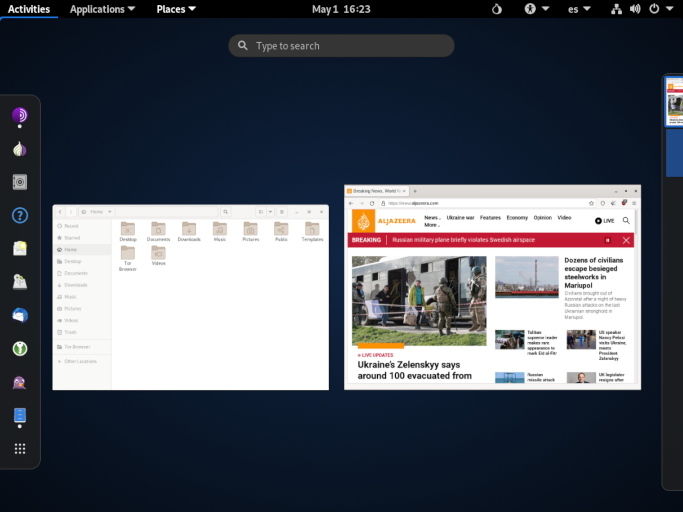 Tails staat voor The amnesic incognito live system en is een live Linux-distributie die zich richt op privacy en anonimiteit. Als basis maakt het gebruik van Debian GNU/Linux en het voegt daar een Gnome-omgeving met Tor, Tor Browser, Pidgin, Thunderbird, Electrum, LibreOffice, GPG en KeePassXC aan toe. Voor meer informatie verwijzen we naar deze pagina. Versie 5 is op Debian 11 gebaseerd en onder meer OpenPGP is vervangen door Kleopatra. In versie 5.8 zijn verder nog de volgende veranderingen en verbeteringen aangebracht:
Tails staat voor The amnesic incognito live system en is een live Linux-distributie die zich richt op privacy en anonimiteit. Als basis maakt het gebruik van Debian GNU/Linux en het voegt daar een Gnome-omgeving met Tor, Tor Browser, Pidgin, Thunderbird, Electrum, LibreOffice, GPG en KeePassXC aan toe. Voor meer informatie verwijzen we naar deze pagina. Versie 5 is op Debian 11 gebaseerd en onder meer OpenPGP is vervangen door Kleopatra. In versie 5.8 zijn verder nog de volgende veranderingen en verbeteringen aangebracht:
New Persistent StorageAfter 2 years of hard work, we are extremelly proud to present you a complete redesign of the Persistent Storage. The Persistent Storage hasn't changed much since its first release in 2012 because the code was hard to modify and improve. But, we learned from users that the Persistent Storage could do a lot more for you if it had more features and was easier to use.
Wayland and better Unsafe Browser
- You don't have to restart anymore after creating the Persistent Storage or each time you activate a new feature.
- You can change the password of your Persistent Storage from this new application.
- You can choose to create a Persistent Storage directly from the Welcome Screen, if you don't have one already.
We replaced the deprecated X.Org display system with Wayland. Even if you won't notice any visual difference, Wayland brings more security in depth to Tails by making it harder for a compromised application in Tails to compromise or misuse another application.
For example, since Tails 4.8, the Unsafe Browser was disabled by default because a security vulnerability in another application in Tails could start an invisible Unsafe Browser, reveal your IP address, and deanonymize you. Wayland fixes this vulnerability and makes it safe to reenable the Unsafe Browser by default. You can still disable the Unsafe Browser in the Welcome Screen. Wayland also brings in other features that were not working yet in the Unsafe Browser:
QR code scanning of Tor bridges
- Sound
- Uploads and downloads
- Alternative input methods for Chinese and other non-Latin languages
- Accessibility features like the screen reader and virtual keyboard
We made it easier to enter new Tor bridges in Tails by scanning a QR code. To get a QR code, you can either:
- Send an empty email to bridges@torproject.org from a Gmail or Riseup email address.
- Get bridges from https://bridges.torproject.org/ and print the QR code on paper.
We are aware that the QR codes that are currently provided are too big to be easy to scan. We are working with Tor to make them smaller and easier to scan.
Changes and updates Fixed problemsWe fixed 3 usability issues in the Tor Connection assistant:
- Display a percentage on the connection progress bar. (#19208)
- Fix links to documentation. (#19172)
- Add a Bridge label in front of the line to enter a custom bridge. (#19169)
For more details, read our changelog.
Known issues
- The switches that turn on and off the different features of the Persistent Storage are very slow to respond on some USB sticks. Please report on #19291 if this happens to you.
- The top of the Welcome Screen is cut out on small displays (800×600), like virtual machines. (#19324) You can press
Alt+Sto start Tails.- When using a custom Tor
obfs4bridge, the progress bar of Tor Connection sometimes gets stuck halfway through and becomes extremelly slow. (#19173) To fix this, you can either:
- Close and reopen Tor Connection to speed up the initial connection.
- Try a different
obfs4bridge. This issue only affects outdated obfs4 bridges and does not happen with obfs4 bridges that run version 0.0.12 or later.See the list of long-standing issues.


:fill(white):strip_exif()/i/2005085794.jpeg?f=thumbmedium)